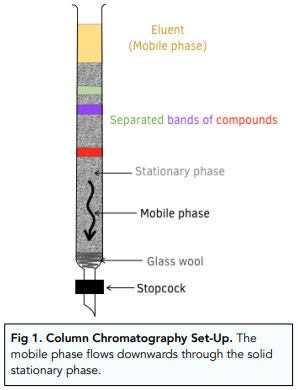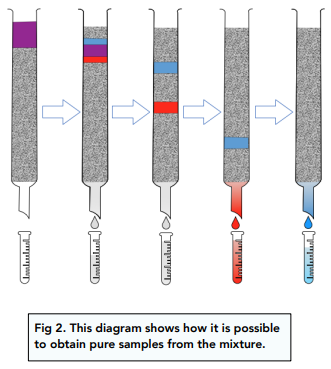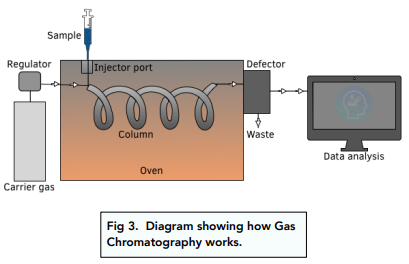Analytical Techniques - Different Types of Chromatography (A-Level Chemistry)
Different Types of Chromatography
Column Chromatography
Column chromatography is another method that can be used to separate out mixtures. It is mainly used to purify an organic product.
- Stationary phase – Column chromatography uses a glass column packed with the powdered stationary phase, usually one of silica or aluminium oxide.
- Mobile phase – A solvent, called the eluent, is added to the top of the column and allowed to run down the glass column.

The molecules in the mixture to be separated have different relative affinities for the solid stationary phase and mobile phase (eluent).
Components with higher solubility for the eluent move through the glass column faster than those with lower solubility.
Different eluents may be necessary to increase the separation, as different components will have varying solubility in the different eluents.
As with thin-layer chromatography, ultraviolet light may be used to show the position of molecules within the column.
The advantage of this technique is that large amounts of mixtures can be separated and collected. This enables pure compounds from a mixture to be separated.

Gas Chromatography
Gas chromatography is used to separate a mixture of volatile liquids.
- Stationary phase – A long capillary tube is packed with the stationary phase. The stationary phase is a solid or a powder that has been coated with a liquid such as oil (usually a viscous liquid is used).
- Mobile phase – The mobile phase is an unreactive gas, usually nitrogen or helium is used.
The sample is injected into the long capillary tube. The tube is contained in an oven which heats the sample to high temperature and turns the sample into a gas.
The gaseous sample moves along with the inert, mobile gas under pressure.

The components of the mixture that are stuck to the oily stationary phase, move slower than those that are carried rapidly by the unreactive gas.
The component that comes out first is least attracted to the solid stationary phase.
Times taken for each component to leave the column are recorded, these are called retention times.
The components of the mixture are identified by comparing their retention times in a known stationary phase with a known mobile phase with a database.
The relative size of the peak relates to the concentration of substances within the mixture.
Gas chromatography is used to identify the level of alcohol in blood or urine.
It is also used in detecting small concentrations of substances, for example environmental pollutants.
Gas Chromatography – Mass Spectrometry
This method involves combining the usefulness of gas chromatography to separate molecules with the ability of mass spectrometry to identify molecules.
The mixture of volatile liquids is first separated using the gas chromatography method, the separated components can then be identified by being fed into a mass spectrometer.
The mass spectrometer can then produce a mass spectrum for each individual component of the volatile liquid mixture, using its fragmentation pattern or its accurate mass to identify the molecule found in the mixture.
High-Performance Liquid Chromatography
If the sample is heat-sensitive or has very high boiling points, then gas chromatography is not suitable as a separation technique. An adapted method known as high-performance liquid chromatography (HPLC) is used instead.
In HPLC:
- Stationary phase – A long capillary tube is packed with a powdered solid stationary phase, usually silica bonded to different hydrocarbons.
- Mobile phase – The mobile phase is a polar liquid mixture, such as methanol with water.
A HPLC procedure goes as follows:
- Sample is injected. Just as in gas chromatography, the sample is injected with the solvent into the HPLC column and travels, under high pressures, in solution along it.
- Mixture components separate. The components in the mixture will travel at different speeds and separate according to their relative affinities to the stationary and mobile phases.
- UV light is passed through the mixture components. UV light gets absorbed by mixture components as they leave the HPLC column. The degree of absorption gets detected by an UV detector producing a chromatogram.
- Retention times are used to identify mixture components. Each component of the mixture can be identified by comparing their retention times with those found in reference databases. Jus as with gas chromatography, HPLC can also be connected to a mass spectrometer in order to identify the molecules in a mixture.
Chromatography is a laboratory technique used in chemistry to separate and analyze a mixture of chemical substances. It is based on the principle that different substances in a mixture will travel at different rates when exposed to a solvent or mobile phase.
There are several types of chromatography, including:
Paper chromatography
Thin-layer chromatography (TLC)
Gas chromatography (GC)
Liquid chromatography (LC)
High-performance liquid chromatography (HPLC)
Supercritical fluid chromatography (SFC)
Paper chromatography is a type of chromatography that uses a sheet of filter paper as the stationary phase. A sample is applied to the paper, and then the paper is exposed to a solvent or mobile phase, which carries the components of the mixture along the paper.
Thin-layer chromatography (TLC) is a type of chromatography that uses a thin layer of solid material, such as silica gel or alumina, as the stationary phase. A sample is applied to the layer, and then the layer is exposed to a solvent or mobile phase, which carries the components of the mixture along the layer.
Gas chromatography (GC) is a type of chromatography that uses a gas as the mobile phase. A sample is introduced into the system, and then the components of the mixture are separated based on their physical and chemical properties as they travel through the column.
Liquid chromatography (LC) is a type of chromatography that uses a liquid as the mobile phase. A sample is introduced into the system, and then the components of the mixture are separated based on their physical and chemical properties as they travel through the column.
High-performance liquid chromatography (HPLC) is a type of liquid chromatography that uses a high-pressure pump to force the mobile phase through the column. This type of chromatography provides higher resolution and greater sensitivity than other types of liquid chromatography.
Supercritical fluid chromatography (SFC) is a type of chromatography that uses a supercritical fluid, such as carbon dioxide, as the mobile phase. This type of chromatography provides a high degree of separation and is useful for separating complex mixtures of compounds.
In A-Level Chemistry, knowledge of different types of chromatography is important for understanding the techniques used to separate and analyze chemical substances. This knowledge is also important for understanding related applications, such as drug analysis and environmental monitoring.






Still got a question? Leave a comment
Leave a comment